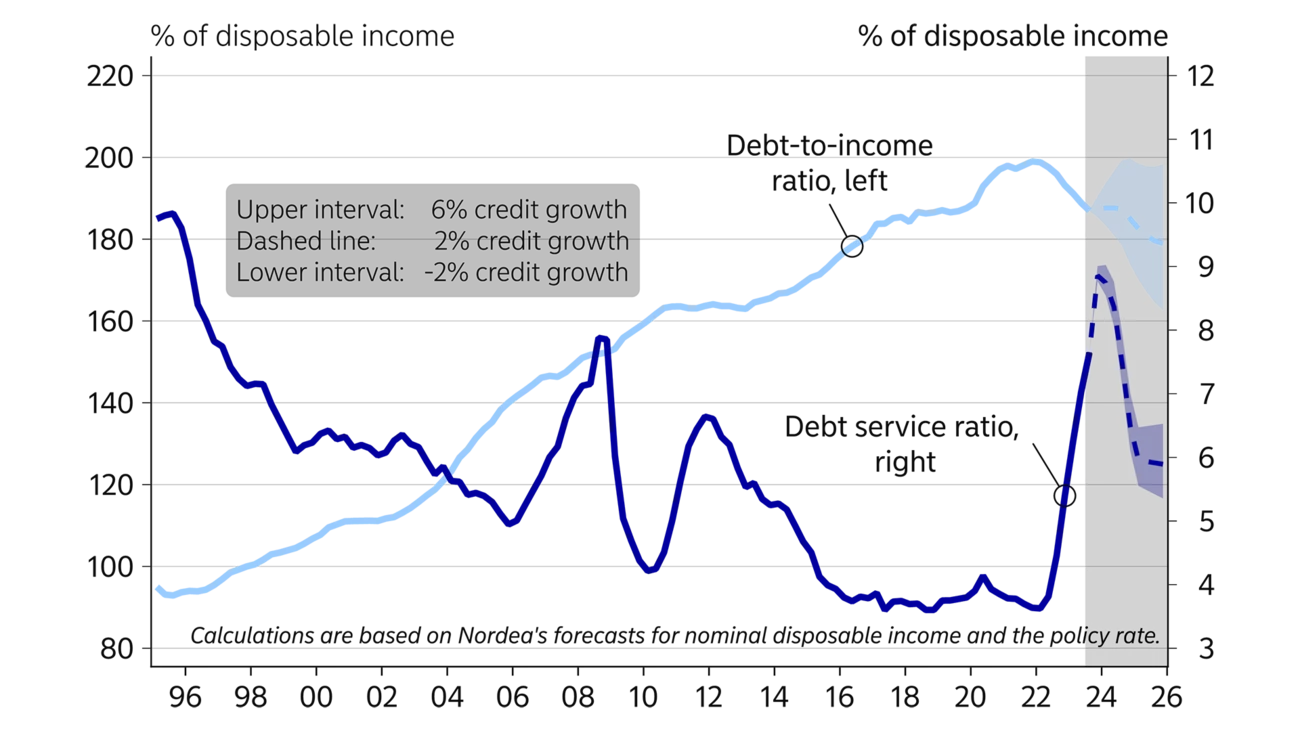
- Name:
- Gustav Helgesson
- Title:
- Nordea Analyst
Swedish household debt relative to income is falling for the first time since the mid-1990s – contributing to resilience in the long term, but raising questions about household spending and housing market trends in the near term.

Rising interest rates, low housing market activity and uncertain economic prospects have led to a steep de-cline in household credit growth. Last year, household borrowing rose by SEK 1.5bn on average per month – a reduction of more than 90% from the record year 2021, when debt rose on average by SEK 25bn per month. The decline is due to lower demand for new loans, while the trend in amortisations seems more stable.
While household net borrowing basically came to a halt in 2023, nominal income rose at an unusually high pace. The income growth is chiefly a result of higher employment and stronger wage growth. Real disposable income fell in both 2022 and 2023, though.
Slower credit growth and faster nominal income increases have led to the debt-to-income (DTI) ratio – household debt relative to nominal disposable income – falling for six consecutive quarters, to 187%, from the peak of 199% in Q1 2022.
As a result of the Riksbank’s rate hikes, coupled with the high debt levels, the debt service ratio – interest payments relative to income – has climbed to the previous peak from the 2000s of 7.6%. The debt service ratio is expected to peak at 9% at the start of this year, but will drop when the Riksbank starts to cut its policy rate in May. Indebtedness affects how much the interest rate level will impact household finances. If the DTI ratio had not declined in the last quarters, the debt service ratio would have been 0.4% points higher, all else equal.
Many households are far more indebted and thus more interest rate-sensitive than the chart shows, as it also includes mortgage-free households. In addition, households that had an LTV ratio close to 85% before housing prices fell have less borrowing capacity today. A calculation from the Riksbank shows that nearly half of new mortgage borrowers hit the mortgage cap after the fall in housing prices.

In the period 2010-19, the policy rate averaged 0.3%. Nordea projects that the policy rate will be cut from the current 4.0% to 2.5% by year-end 2024. Relatively high interest rate levels, more cautious households and low activity on the housing market indicate continued dampened credit growth in the coming years. Thus, we expect household debt to rise by 2% on average annually in 2024-25, compared to an annual 6% increase on average in the decade before the pandemic. In this scenario, nominal disposable income grows faster than debt, bringing the DTI ratio to 180% by year-end 2025.
The development in the DTI ratio is difficult to predict and largely depends on other developments in the general economy. When housing market activity picks up, the demand for loans will likely rise again. The top interval in the chart shows that the DTI ratio would reach its previous high at annual credit growth of 6%. Conversely, a continued decline in housing prices and unexpectedly high interest rates could instead lead to household debt starting to fall in actual figures. The lower interval shows that the DTI ratio will fall to 165% when debt is expected to decline by 2% annually. Given Nordea’s forecast that the policy rate will be lowered to 2.5% by year-end 2024 and kept on hold in 2025, the debt service ratio will fall to 6% – slightly above the 2000-19 average of 5.5% and much higher than in the pre-pandemic years. In other words, households’ interest burden is expected to ease in the future, but will remain higher than many have become used to.
Households’ interest burden is expected to ease in the future, but will remain at a higher level than many have become used to.
Excessive indebtedness can pose a risk to financial stability. In this sense, a lower DTI ratio could strengthen resilience, going forward. However, debt restructuring is not cost-free. The Swedish economy has not seen a similar decline in credit growth in 25 years. In the near term, it will result in lower spending and investments, which could prolong the economic slowdown. In the longer term, a lower DTI ratio will better equip households for future rate hikes.
This article first appeared in the Nordea Economic Outlook: Past the peak, published on 24 January 2024. Read more from the latest Nordea Economic Outlook.


Sustainability
Amid geopolitical tensions and fractured global cooperation, Nordic companies are not retreating from their climate ambitions. Our Equities ESG Research team’s annual review shows stronger commitments and measurable progress on emissions reductions.
Read more
Sector insights
As Europe shifts towards strategic autonomy in critical resources, Nordic companies are uniquely positioned to lead. Learn how Nordic companies stand to gain in this new era of managed openness and resource security.
Read more
Open banking
The financial industry is right now in the middle of a paradigm shift as real-time payments become the norm rather than the exception. At the heart of this transformation are banking APIs (application programming interfaces) that enable instant, secure and programmable money movement.
Read more